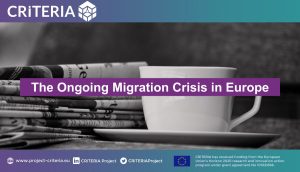The 2022 Russian invasion of Ukraine created a large wave of refugees fleeing the country. Four months after the start of the war, the UN Refugee Agency (UNHCR) reported 5.1M Ukrainian refugees. By September 2022, more than 4M people had registered for protection schemes in European countries, especially in Poland with more than 1.3M and Germany with more than 700k persons (see Figure 1). This makes the situation in sheer numbers comparable with the European refugee crisis of 2015-2018.

Figure 1: Refugees from Ukraine recorded by country (Source: UNHCR).
The conflict in Ukraine and the resulting migration received much attention in mass and social media. At the same time, there seems to be a more positive framing of the migration topic, specifically toward refugees from Ukraine. Before the escalation of the present crisis, media coverage and government policies on migration mainly focused on other groups coming from conflict zones, such as Syria, Ethiopia, or Afghanistan. However, the discussion back then tended to be about economic and security threats. Several media content analyses have shown frequent use of negative terminology such as ‘illegal’, ‘violence‘, and ‘terrorist’ in this context. Moreover, news reports have linked certain crimes or socioeconomic issues like the rise of unemployment to immigration. It does not come as a surprise that public attitudes towards migration are influenced by information from the press as well as by political agendas in the respective European countries.
In contrast, in 2022, the humanitarian crisis at the EU border resulting from Ukrainians escaping the war prompted a massive reaction of support by the western media and a great display of solidarity from the European public in particular. Several differences might have triggered this change. For example, the intensive reporting about the war situation raises empathy. The European public may remember there was also a more ‘welcoming’ culture during the war in Syria. Another differentiating factor is the demographic contrast in the migrant population. While many people from the Middle East seeking refuge are male, about 90% of the refugees from Ukraine are female. However, another significant difference seems to be the cultural proximity of Ukraine to the EU compared to refugees from the Middle East or Africa.
Study Setup
In a recent study to be presented at The Web Conference 2023, we investigate whether or not the general impression of a stance shift towards migration is confirmed by how the topic is reflected in online news and social media, thus, linking the representation of the issue on the Internet to its perception in society. The abundance of audience interactions with news on social media channels like Twitter provides a precious data source for understanding users’ engagement patterns and evolving opinions on sensitive social topics. For this analysis, we collected 5.5M Twitter posts published by 565 European news outlets over one year (starting September 2021). Additionally, we gathered replies from their audiences to these tweets as a way to sense the public response. Based on this data, we conduct a multilingual analysis of migration-related media coverage and corresponding social media interaction in Europe. In particular, we focus on the five western and central European countries France, Germany, Italy, Poland, and Spain.
To illustrate the change in the tone of the discussion, we contrast the language and related sentiment expressed by the mass media in their online coverage of refugee crises before and after February 2022 (see Figure 2). Moreover, we examined the reaction of the EU audience through their engagement on Twitter with migration/refugees-related news. For this, we use an original and effective methodology based on automatic natural language processing and machine learning that allows us to infer the users’ stances on the topic. The novelty of our approach to stance detection lies in its systematic multilingualism and in the context-aware way the content is collected. In contrast to other methods, we do not rely on keywords or hashtags to select suitable responses, which can introduce some biases in the analysis.

Media Coverage Shift
Our results indeed show a reframing of the discussion in news media. When comparing coverage from November 2021 and March 2022, this is evident in the change in terminology, for example, from ‘migrant‘ to ‘refugee‘, often even accentuated by phrases such as ‘real refugees’. Worries about the impact of migration on society dominate pre-invasion media discourse. This concern seems to disappear from the media coverage after February 2022.
Public Perception
The picture is more heterogeneous than expected regarding a change in public perception. Although we observed a noticeable stance shift in the positive direction for all countries at the beginning of the Ukraine invasion, this varies in magnitude and duration across the different countries. This shift can be seen most clearly in Poland, which is also the country most affected by the following refugee movement. There, a lasting change in attitude is also evident. At the same time, the effect in the other countries is less stable and fades after about three to four months. In contrast, the impact of another recent crisis at the Belarus-EU border in Poland is accompanied by a noticeably negative attitude both in the public and media coverage.
Advantages of the Approach
Our multilingual stance detection method has proven very effective for the study, allowing automatic and intelligent processing of large amounts of social interactions. Furthermore, it can be generalized to other languages without additional training, which extends the impact of our methodology by facilitating the comparison of the situation in multiple countries. These multilingual, multi-country models can produce further insights into societal processes such as migration.
There are various directions for future sociology and technology research. Examples include a deeper analysis of the reasons for the differences between European countries, distinction in the interaction of individual media with their audience, and the analysis of specific narratives around migration. However, an effective method to systematically identify and monitor media and public attitude over time in a fundamental issue such as migration is an important step to better understand our society and contributes to its aspired continued positive development.
More results and in-depth analysis can be found in the paper “Migration reframed? A multilingual analysis on the stance shift in Europe during the Ukrainian crisis” now available for download in the CRiTERIA’s publication hub.

Erick Elejalde, PhD
Erick Elejalde received the M.Sc. and Ph.D. degrees in computer science from the University of Concepción, Concepción, Chile, in 2013 and 2018, respectively. He is currently a Post-Doctoral Researcher with the L3S Research Center, Leibniz University Hannover, Hannover, Germany. His research interests include computational social science, online media-behavior modeling, and social networks.

Sergej Wildemann
Sergej Wildemann is a research assistant and Ph.D. candidate at L3S Research Center. He completed his master's degree in Computer Science from Leibniz University Hannover. His research interest expands to digital libraries, temporal information retrieval, and social media analysis.
Banner image by Dusan Cvetanovic on Pixaby.




